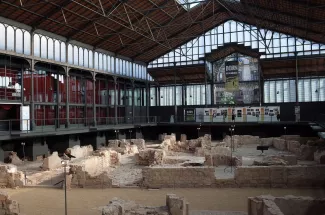What Other Names Has Barcelona Had Throughout History?
Barcelona has gone by many names over the centuries — each reflecting a different chapter of its long and layered story. From Roman origins to literary nicknames, these names reveal how the city has been seen, claimed, and celebrated across time.
Barcino: The Roman Roots of Barcelona
The oldest recorded name of the city is Barcino, founded as a Roman colony in the 1st century BCE. Its full name was Colonia Iulia Augusta Faventia Paterna Barcino, a mouthful that reflected its imperial favor.
Today, you can still see traces of Barcino in the Gothic Quarter — Roman walls, tombs, and even street layouts remain part of the living city.
Barchinonem / Barchinona (Medieval Latin)
As Latin evolved during the Middle Ages, so did the city’s name. Barchinonem appears in early charters and legal documents. It reflects the city’s rise as a medieval center of trade and power.
Barshalūna / Barsalūna (Arabic sources)
During the early 8th to 10th centuries, when Al-Andalus extended into parts of the Iberian Peninsula, Arabic texts referred to the city as Barshalūna or Barsalūna. Though Muslim rule in Barcelona was short-lived, this name appears in historical chronicles and geographical works.
Ciutat Comtal (The Comital City)
In the High Middle Ages, Barcelona became the capital of the County of Barcelona, a powerful Christian polity. "Ciutat Comtal" — meaning Comital City in Catalan
Barna (Local abbreviation)
Ask any local and they’ll tell you: "We say Barna, not Barça."
Barna is the everyday, affectionate shorthand for Barcelona among its residents. It’s widely used in casual conversation and local media — a marker of insider status.
La Rosa de Foc (The Rose of Fire)
This poetic nickname emerged during the industrial era, particularly in the late 19th and early 20th centuries, when Barcelona was a hotbed of anarchist and workers' movements.
It captures the city’s revolutionary spirit, artistic energy, and political fire.
La Ciutat dels Prodigis (The City of Marvels)
Popularized by the acclaimed novel by Eduardo Mendoza, this name evokes Barcelona’s explosive transformation between the Universal Exhibitions of 1888 and 1929.
It has since become a beloved literary and cultural nickname for the city. Read this book before coming to Barcelona!
La Capital Catalana (The Catalan Capital)
Today, Barcelona is recognized as the political and cultural capital of Catalonia.
Whether in politics, language, art, or innovation, it continues to lead — not just as a city, but as a symbol of Catalan identity.
Barcelona (Modern name in Catalan and Spanish)
The name "Barcelona" as we know it today comes from centuries of linguistic evolution.
In Catalan, it’s pronounced bər-sə-LO-nə.
In Spanish, it’s bar-the-LO-na or bar-se-LO-na, depending on the accent.
One name — many ways to say it, many stories behind it !!!
What Does “BCN” Mean?
BCN is the international abbreviation for Barcelona, most commonly used in airport codes, travel documents, and modern shorthand. It comes from the city’s IATA airport code — BCN — which identifies Barcelona–El Prat Airport.
Today, locals and travelers alike use “BCN” in hashtags, social media, tourism campaigns, and even streetwear. So if you see #BCN, know that it’s just another way to say Barcelona — short, modern, and unmistakably international.

